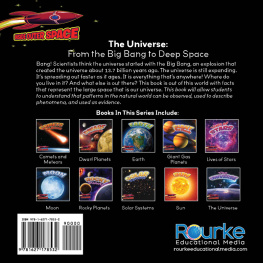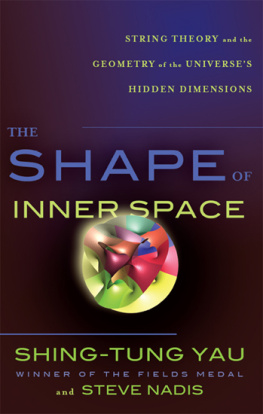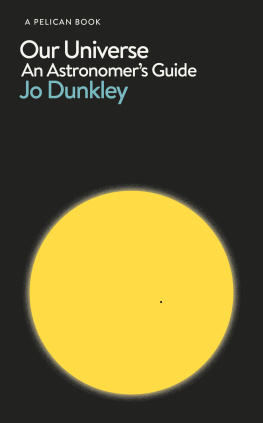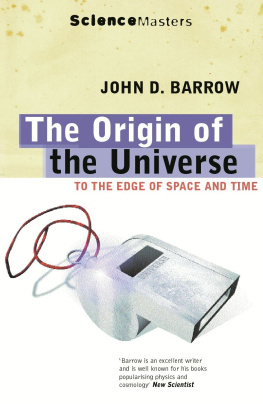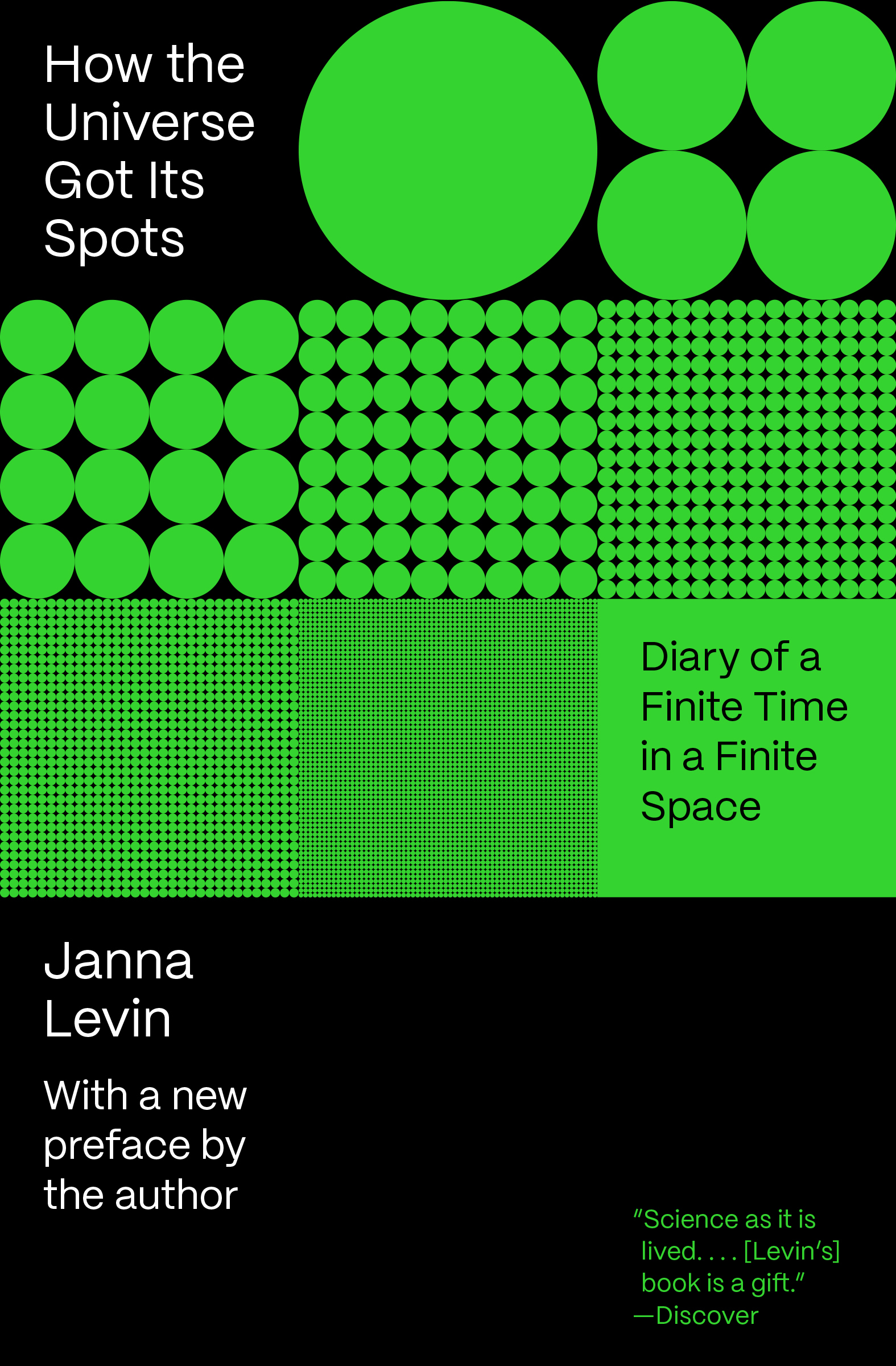More praise for
HOW THE UNIVERSE GOT ITS SPOTS
___________________________
Gives a personal resonance to scientists attempts to understand the mysteries of the universe.
Washington Post
Levin not only tours the wilder reaches of cosmology, but she also bares her soul.
New Scientist
Levin interweaves enlightening insights into the most profound enigmas of space, time and infinity with reflections on her struggle to balance her personal and professional lives. The result suggests a blend of Zen and the Art of Motorcycle Maintenance and The History of Time.
DAN KINCAID, Arizona Republic
Levin unpacks the technicalities with a skill honed from giving many lectures on the subject, and it is fascinating to read. A book to be applauded.
ANDREW CRUMEY, The Scotsman
The intellectual-emotional balance, and the finely tuned prose, are what makes this different from the very many other books on cosmology. And Levin has found an interesting way to do this; the book is in the form of letters to her mother.
Globe and Mail
[A] touchingly personal account.
JIM MCCLEAN, The Herald (Glasgow)
A genuine attempt to break down barriers, both intellectual and emotional, between scientists and their wished-for audience.
KEN GRIMES and ALISON BOYLE, Astronomy
If the universe is infinite, then its possibilities are infinite as well. But in How the Universe Got Its Spots, the astrophysicist Janna Levin insists that infinity works as a hypothetical concept only, and that it is not found in nature.
LAUREN PORCARO, The New Yorker
Although were tantalizingly close to the answer, we still dont know if our universe is infinite or finite. Janna Levin, one of the bright young stars on the interface between topology (the study of shapes) and cosmology, describes her efforts to look for the signatures of a finite universe and offers the reader a unique insight into her life and inner thoughts.
DAVID SPERGEL, Princeton University
Janna Levin is one of the most talented and original of the young cosmologists, and her book combines a tour of the frontiers of cosmology with an intimate account of her struggles to reconcile the demands of a scientific career with the demands of the heart. No other scientist has yet had the courage to write such an honest and personal account of what it is like to live the life of a scientist.
LEE SMOLIN, author of The Life of the Cosmos and Three Roads to Quantum Gravity
This is a totally charming piece of work. A memoir of one very talented young woman, it layers her personal odyssey and bits of science like an exotic piece of intellectual/personal pastry. The attitude toward the subject is that of the artist: feelings matter, pictures matter, intuitions matter. Levins book is a wonderful read that introduces current science from an odd angle in a lively, accessible, and engaging fashion. I have never read a book like it.
JEREMIAH P. OSTRIKER, Cambridge University
HOW THE
UNIVERSE
GOT ITS SPOTS
HOW THE
UNIVERSE
GOT ITS SPOTS
DIARY OF A FINITE TIME IN A FINITE SPACE
Janna Levin
With a new preface by the author
Princeton Oxford
Princeton University Press
Princeton and Oxford
Published in the United States, Canada, and the Philippine
Islands by Princeton University Press, 41 William Street, Princeton, New Jersey 08540
First published in Great Britain in 2002 by
Weidenfeld & Nicolson Ltd, London
New paperback edition, with a new preface by the author, 2023
Paperback ISBN 9780691232270
ISBN (e-book) 9780691232287
LCCN: 2022938989
Version 1.0
Copyright 2002 by Janna Levin
Preface to the new parperback edition, copyright 2023 by Janna Levin
All rights reserved
No part of this publication may be reproduced, stored in a retrieval system, or transmitted in any form or by any means, electronic, mechanical, photocopying, recording, or otherwise, without the prior permission of the copyright owner.
The moral right of Janna Levin to be identified as the author of this work has been asserted in accordance with the Copyright, Designs and Patents Act of 1988.
Typeset by Selwood Systems, Midsomer Norton
Cover design by Katie Osborne
press.princeton.edu
CONTENTS
ACKNOWLEDGEMENTS
I am so grateful to everyone who took care of me in California and in New York especially Angelina de Antonis, Jason Coleman, Alene Dawson, Nancy Eastep, Sean Hayes, Eno Jackson, Rory Kelly, Prudence Longaker, Sean McGuire, Sylvie Myerson, Diane Olivier, Ruthonly, Sara Jane Parsons, Karen Rait, Andy Rasmussen, Will Waghorn, the San Francisco drawing group, and everyone in the Oakland commune. Thanks to Warren Malone for providing so much material and to all the support in London from Bergit Arends, Jaki Arthur, Paul Bonaventura, Bernard Carr, Sarah Dunant, Sin Ede, Pedro Ferreira, Jem Finer, Naama Gidron, Jonathan Halliwell, Annabell Huxley, Chris Isham, Mark Lythgoe, Joao Magueijo, Sallie Robbins, Valerie Rosewell, Lee Smolin, Richard Wentworth, Tom Wharton, Pitt Wuehrl, PPARC, DAMTP, the CfPA, and the Theoretical Physics Group at Imperial College, the sci/art community, and everyone on the fourth, Brian Deegan, Eric Jorrin, Whitney Hanscom, Ben McLaughlin, Tim Williams and Blast Theory, and to my friends and colleagues I have worked with and who have taught me so much about topology and cosmology, John Barrow, Dick Bond, Neil Cornish, Giancarlo de Gasperis, Imogen Heard, Jean-Pierre Luminet, Dmitry Pogosyan, David Spergel, Glenn Starkman, Evan Scannapieco, Joe Silk, George Smoot, Tarun Souradeep and Jeff Weeks. Forgive me anyone I have carelessly omitted. I am especially grateful to my editor Peter Tallack for his insight and vision. I dont know how to acknowledge the seemingly endless support of my family. Thank you Leslie Levin for not letting me back down. Thank you John Hibbard, Ari and Jack Hibbard, Stacey and Cami Levin, the Jacobsons, the Kavins, the Levins and Eve Jacobson, and most of all Sandy and Richard Levin.
PREFACE TO THE 2023 EDITION
I am rereading How the Universe Got Its Spots as though the diary was authored by someone else, which to some extent it was, if not by someone else entirely. Im privy to the same recollections that are recounted in these pages, though mine are currently more diffuse, less immediate, and less accurate, permuted by time and experience. Though Im disadvantaged by the erosion of those impressions and by the unconscious revision of personal history, I do have the advantage of hindsight. I am the future me, interpreting the past with a knowledge of things to come, reading the words of the former me, watching in the theater of my own mind as a representative of a prior self grapples with the uncertainty of immediacy. And Im resisting revision.
I intended for incertitude to permeate the book. I pay homage to and have respect for the confidence of the classic scientific works by the accomplished and the laudedits perfectly sensible for a renowned expert to share a lifetime of hard-earned knowledge, intuition, discovery, and acclaim. I have many such books on my own shelves. The authors wrote from the vantage of success and achievement. They knew the storys end: Revelation. And though the tales were often thrilling, the discoveries monumental, and the understanding of the universe conveyed literally mind-altering, there was a vertical gulf between the author and the reader that I wanted to undermine. The certainty itself I wanted to undermine. I did not know my storys end. Precisely because of my precarious status as a young, neoteric explorer, not yet secured in the ranks, I hoped to convey both the thrill and the anxiety of not knowing. I wanted to share with anyone who would listen not just revelations, though there are those in this book too, but also the fragile ideaslavish ideasthat might otherwise be lost.



